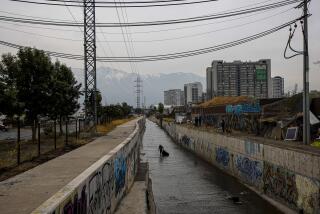A Plague of Unemployment Threatens Vietnam’s Drive for Economic Reform : Southeast Asia: High birthrate, military cutbacks and a flood of returning guest workers add to the problem.
- Share via
HANOI — When the Soviet Bloc still existed and socialist fraternity counted for something, Nguyen Van Dong made a good living as a guest worker earning $450 a month at a factory in Czechoslovakia.
But when his contract ran out, communism had ended in Eastern Europe and Dong was sent home to face an uncertain future. He has been unable to find a job in three years.
Now Dong works as a barber for 30 cents a day on Hanoi’s Hair Cutting Street, where the work is improvised and there is no overhead apart from a rickety chair on the sidewalk. “I don’t think I’ll ever find a job. Life is very hard in Vietnam,” said Dong, who trained as a barber in the Vietnamese army.
As Dong’s plight illustrates, Vietnam is being hit by a wave of unemployment that is threatening to undermine the government’s efforts to reform the moribund socialist economy. As a result, the government appears to be slackening the pace of reforms to prevent the unemployment rate from surging.
For the first time in memory, beggars now throng the streets of Vietnam’s capital seeking handouts of money and food. While begging has been commonplace in southern Vietnam for some time, it was never tolerated in the north.
In addition to beggars, the streets are lined with petty entrepreneurs selling a few cans of beer or loaves of bread or offering a bicycle taxi ride. They are all unemployed.
Official estimates place the level of unemployment at slightly more than 10% of the working-age population of 34 million. But Western economists put the level of unemployment closer to 40%.
“There is a widening gap between the rich and poor,” said Nguyen Huu Dung, director of Vietnam’s Department of Labor and Social Policy. Dung noted a disturbing trend: In recent years, there has been abundant food in the markets but a growing number of people without enough money to shop.
Last year, the government classified 8.5 million people as “hungry,” defined as those who don’t have enough food for three months. Vietnam has a population of 67 million.
There appear to be several new sources of unemployment adding to the problem of a birthrate of 2.2%, which puts 1.1 million youngsters on the street looking for jobs each year.
Vietnam sent 200,000 highly skilled workers to the East Bloc, but since the collapse of communism most have been told to leave. An estimated 100,000 are expected to return home this year, and three planeloads of returning workers arrive each day from Eastern Europe. In addition, 16,000 workers were sent home from Iraq during the Persian Gulf War, and most of those have yet to find jobs.
Another major source of unemployment is the army, which has been downsized considerably since Vietnam withdrew its forces from Cambodia in September, 1989. Now standing at 850,000 men, the army was reduced by 500,000 soldiers between 1989 and 1990. Western diplomats in Hanoi said the government has given indications that it plans to reduce the military to about 600,000.
The cuts have been so great that defense officials are reported to be concerned about the possibilities of civil strife after a major demobilization, because most soldiers take their weapons when they leave the military.
The last major source of new unemployment is from state factories, where unproductive employees have started to be “streamlined,” to use the Vietnamese phrase for laid off, in keeping with the government’s program of doi moi , or economic restructuring.
According to official statistics, 700,000 state employees have been “streamlined” in the last two years. But officials maintain that only 30% of those laid off have been unable to find new jobs.
State enterprises were particularly hard hit by the collapse of the Soviet Union, which until 1991 had been Vietnam’s largest trading partner. Items such as textiles formed the bulk of the exports to the Soviet Union.
Western economists believe that the Vietnamese government has applied the brakes to streamlining because of the feeling that more unemployment is unacceptable at this time. “They are going for the sickest companies first and the smaller rather than the big ones,” one Western analyst said.
Instead of laying people off, he said, the big factories are simply cutting working hours. None of the newly unemployed receive unemployment compensation from the government, which can make life extremely difficult if the streamlined worker has no immediate family to fall back on.
Many of the workers returning from Eastern Europe have accumulated small nest eggs of about $2,000 that they were paid as severance, along with free passage back to Vietnam.
Germany and Vietnam are currently negotiating an agreement that would provide about $6 million in soft loans for guest workers recently repatriated from the former East Germany.
The agreement has been held up by German demands that Vietnam agree to allow all workers to return without penalty, including some who requested political asylum rather than return home.
Officials in Hanoi noted that the unemployment figures don’t really take into account the rural areas, where most Vietnamese live and work in agriculture. There underemployment, with too few acres of land to go around, is viewed as the greatest problem.
Birth control is rarely used in the rural areas because farmers now regard big families as a source of cheap farm labor.
“The birthrate is a big problem for us,” said Dung. “It stands at more than 2%, but I don’t think we have the means to decrease it greatly. The household economy needs more labor.”
More to Read
Sign up for Essential California
The most important California stories and recommendations in your inbox every morning.
You may occasionally receive promotional content from the Los Angeles Times.










